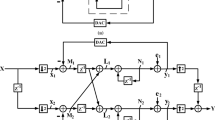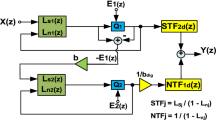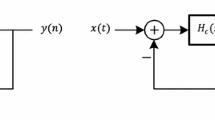Abstract
An analog-to-digital converter based on the time-interleaved delta-sigma modulator is a proper method for high-speed ADCs. Time-interleaved delta-sigma modulators (TIDSM) can be successfully implemented with the development of the block digital filtering (BDF) technique. In this method, M mutually cross-connection delta-sigma modulators are used, with each one operating at a sampling rate of \({\text{f}}_{\text{s}}\) hence, the effective sampling rate will be \({\text{M}}*{\text{f}}_{\text{s}}\) However, SNDR is approximately equal to the single path standard structure. In this paper, a new structure based on the Noise Coupled time-interleaved delta-sigma modulator is proposed to increase the overall noise transfer function order without any additional active element. This improvement is analytically verified and then validated using simulations. Also, some practical issues regarding the implementation of the proposed structure, such as, finite op-amp’s gain and mismatching effects are discussed. Also, analyzes and some practical solutions are presented. The results of the simulation at the system level show that the SNDR of the proposed first-order two-channel structure is 18 dB better than its BDF technique counterpart, for the second-order two-channel TIDSM, the SNDR of the proposed structure is 13 dB better than that of the BDF technique.













Similar content being viewed by others
References
Khoury, J., & Tao, H. (1998). Data converters for communication systems. IEEE Communications Magazin,36(October), 113–117.
Maloberti, F. (2007). Data converters. Berlin: Springer.
Ren, J., Sarwana, S., Sahu, A., Talalaevskii, A., & Inamdar, A. (2015). Low-pass delta-delta-sigma ADC. IEEE Transactions on Applied Superconductivity,25(March), 1–6.
Tao, S., & Rusu, A. (2015). A power-efficient CT incremental Σ∆ ADC for multi-channel neural recording systems. IEEE Transactions on Circuits and Systems I: Regular Papers,62(June), 1–10. https://doi.org/10.1109/tcsi.2015.2418892.
Shanthi, P., Schreier, R., & Temes, G. C. (2017). Understanding delta-sigma data converters. New York: Wiley.
Moradi, R., Farshidi, E., & Soroosh, M. (2018). Digital calibration of memory errors in passive sigma-delta modulator. IETE Journal of Research,2063(Jun), 1–8. https://doi.org/10.1080/03772063.2018.1473056.
Balmelli, P., & Huang, Q. (2004). 4.2 A 25MS/s 14b 200 mW Σ∆ modulator in 0.18 µm CMOS. In 2004 IEEE international solid-state circuits conference, 2004. Digest of technical papers. ISSCC, pp. 74–514.
Lee, H., AurangozebPark, S., Kim, J., & Kim, C. (2014). A 6-bit 2.5-GS/s time-interleaved analog-to-digital converter using resistor-array sharing digital-to-analog converter. IEEE Transactions on Very Large Scale Integration (VLSI) Systems,23(November), 1–13.
Bolatkale, M., Breems, L. J., Rutten, R., & Makinwa, K. A. A. (2011). A 4 GHz continuous-time ΔΣ ADC with 70 dB DR and − 74 dBFS THD in 125 MHz BW. IEEE Journal of Solid-State Circuits,46(December), 2857–2868. https://doi.org/10.1109/JSSC.2011.2164963.
Maghari, N., & Moon, U. (2014). Emerging analog-to-digital converters. In ESSCIRC 2014-40th European solid state circuits conference (ESSCIRC), IEEE, pp. 43–50.
Beydoun, A., Nguyen, V. T., & Loumeau, P. (2010). A novel digital calibration technique for gain and offset mismatch in parallel TIΣΔ ADCs. In ICASSP, IEEE international conference on acoustics, speech and signal processing—Proceedings, pp. 4158–4161. https://doi.org/10.1109/icassp.2010.5495721.
Han, C., & Maghari, N. (2015). Time-interleaved noise-coupling delta-sigma modulator using modified noise-shaped integrating quantizer. IEEE Journal on Emerging and Selected Topics in Circuits and Systems,5(April), 548–560. https://doi.org/10.1109/JETCAS.2015.2502163.
Beydoun, A., Nguyen, V. T., Naviner, L., & Loumeau, P. (2013). Optimal digital reconstruction and calibration for multichannel time interleaved ΣΔ ADC based on Comb-filters. AEU—International Journal of Electronics and Communications,67(April), 329–339. https://doi.org/10.1016/j.aeue.2012.10.004.
Lee, S., Chandrakasan, A. P., & Lee, H. (2014). A 1 GS/s 10b 18.9 mW time-interleaved SAR ADC with background timing skew calibration. IEEE Journal of Solid-State Circuits,49(December), 2846–2856.
Abbaszadeh, A., Aghdam, E. N., & Rosado-Muñoz, A. (2019). Digital background calibration algorithm and its FPGA implementation for timing mismatch correction of time-interleaved ADC. Analog Integrated Circuits and Signal Processing,9, 299–310. https://doi.org/10.1007/s10470-019-01443-9.
Monsurrò, P., Rosato, F., & Trifiletti, A. (2018). New models for the calibration of four-channel time-interleaved ADCs using filter banks. IEEE Transactions on Circuits and Systems II: Express Briefs,65(February), 141–145. https://doi.org/10.1109/TCSII.2017.2662084.
Eshraghi, A., & Fiez, T. S. (2004). A comparative analysis of parallel delta-sigma ADC architectures. IEEE Transactions on Circuits and Systems I: Regular Papers,51(March), 450–458. https://doi.org/10.1109/TCSI.2004.823663.
Kurosawa, N., Kobayashi, H., Maruyama, K., Sugawara, H., & Kobayashi, K. (2001). Explicit analysis of channel mismatch effects in time-interleaved ADC systems. IEICE Transactions on Fundamentals of Electronics, Communications and Computer Sciences,48(April), 749–756. https://doi.org/10.1109/81.915383.
Riewruja, V., & Chaikla, A. (2004). A high-speed algorithmic ADC. International Journal of Electronics,91(December), 719–733. https://doi.org/10.1080/00207210412331332862.
Talebzadeh, J., & Kale, I. (2018). A novel two-channel continuous-time time-interleaved 3rd-order sigma-delta modulator with integrator-sharing topology. Analog Integrated Circuits and Signal Processing,95(3), 375–385. https://doi.org/10.1007/s10470-018-1125-5.
Aziz, P. M., Sorensen, H. V, & Van der Spiegel, J. (1994). Multi band sigma delta analog to digital conversion. In ICASSP-94, 1994 IEEE international conference on acoustics, speech, and signal processing, 1994, Vol. 3, pp. III/249–III/252. Retrieved from https://doi.org/10.1109/icassp.1994.390021.
Cormier, R. F., Sculley, T. L., & Bamberger, R. H. (1994). Combining subband decomposition and sigma delta modulation for wideband A/D conversion. In Proceedings of IEEE international symposium on circuits and systems—ISCAS’94, pp. 357–360. https://doi.org/10.1097/spc.0b013e32836575e3.
Galton, I., Jensen, H. T., & Member, S. (1995). Delta-sigma modulator based A/D conversion without oversampling. IEEE Transactions on Circuits and Systems,42(December), 773–784.
Galton, I., & Jensen, H. (1996). Oversampling parallel delta-sigma modulator A/D conversion. IEEE Transactions on Circuits and Systems,43(December), 801–810.
Khoini-poorfard, R., Lim, L. B., & Johns, D. A. (1997). Time-interleaved oversampling A/D converters : Theory and practice. IEEE Transactions on Circuits and Systems,44(August), 634–645.
Prakash, A. V. J., Jose, B. R., Mathew, J., & Jose, B. A. (2017). A triple-mode hexa-standard reconfigurable TI cross-coupled ΣΔ modulator. International Journal of Electronics,104(July), 1142–1160. https://doi.org/10.1080/00207217.2017.1285441.
John, D., & Martin, K. (2008). Analog integrated circuit design. New York: Wiley. https://doi.org/10.1007/978-3-319-34060-9.
Razavi, B. (2013). Design considerations for interleaved ADCs. IEEE Journal of Solid-State Circuits,48(August), 1806–1817. https://doi.org/10.1109/JSSC.2013.2258814.
Kozak, M., & Kale, I. (1999). A novel topology for time-interleaving in oversampling delta- sigma modulators. In 1999 Third international conference on advanced A/D and D/A conversion techniques and their applications, pp. 27–28. https://doi.org/10.1016/j.gloplacha.2012.06.001.
Yao Lu, C., Yu Hsieh, C., Liang Chen, H., & Shiun Chiang, J. (2009). A high-resolution time-interleaved delta-sigma modulator with low oversampling. In Proceedings of the 2009 12th international symposium on integrated circuits, pp. 14–17.
Huang, Y. C., Wang, Z. G., Liu, W. F., & Zheng, X. (2011). Design of a delta-sigma modulator structured in MASH 2-1-2 with dither of error feedback. In 2011 International conference on applied superconductivity and electromagnetic devices, ASEMD 2011, pp. 33–36. https://doi.org/10.1109/asemd.2011.6145061.
Fitzgibbon, B., Member, S., & Kennedy, M. P. (2011). Calculation of cycle lengths in higher order error feedback modulators with constant inputs. IEEE Transactions on Circuits and Systems,58(January), 6–10.
Teymouri, B., & Najafi Aghdam, E. (2015). Stability and sensitivity and optimization of delta sigma modulators. In 2015 23rd Iranian conference on electrical engineering, pp. 1245–1248.
Chen, Y., Zhong, S., & Dang, H. (2009). The application of Monte Carlo analysis in the sigma-delta modulators stability design. In 2009 WRI world congress on computer science and information engineering, CSIE 2009, Vol. 3, pp. 380–383. https://doi.org/10.1109/csie.2009.773.
Sedra, A. S. (2008). Analog MOS integrated circuits for signal processing. Proceedings of the IEEE. https://doi.org/10.1109/proc.1987.13922.
Majd, N. E., Ghafoorifard, H., & Mohammadi, A. (2015). Bandwidth enhancement in delta sigma modulator transmitter using low complexity time-interleaved parallel delta sigma modulator. AEU—International Journal of Electronics and Communications,69(7), 1032–1038. https://doi.org/10.1016/j.aeue.2015.04.001.
Talebzadeh, J., & Kale, I. (2017). Design and simulation of a 3rd-order discrete-time time-interleaved delta-sigma modulator with shared integrators between two paths. In 2017 25th Iranian conference on electrical engineering, ICEE 2017, Vol. 2, pp. 197–200. https://doi.org/10.1109/IranianCEE.2017.7985431.
Hamidi, B., & Miar-Naimi, H. (2014). Extended noise shaping in sigma-delta modulator using cross-coupled paths. IEEE Transactions on Circuits and Systems I: Regular Papers,61(6), 1675–1686. https://doi.org/10.1109/TCSI.2013.2295893.
Author information
Authors and Affiliations
Corresponding author
Additional information
Publisher's Note
Springer Nature remains neutral with regard to jurisdictional claims in published maps and institutional affiliations.
Rights and permissions
About this article
Cite this article
Abdoli, M., Najafi Aghdam, E. & Hemmati, F. A novel noise-coupled time-interleaved delta-sigma modulator with analysis of practical limitations. Analog Integr Circ Sig Process 102, 389–401 (2020). https://doi.org/10.1007/s10470-019-01571-2
Received:
Revised:
Accepted:
Published:
Issue Date:
DOI: https://doi.org/10.1007/s10470-019-01571-2




